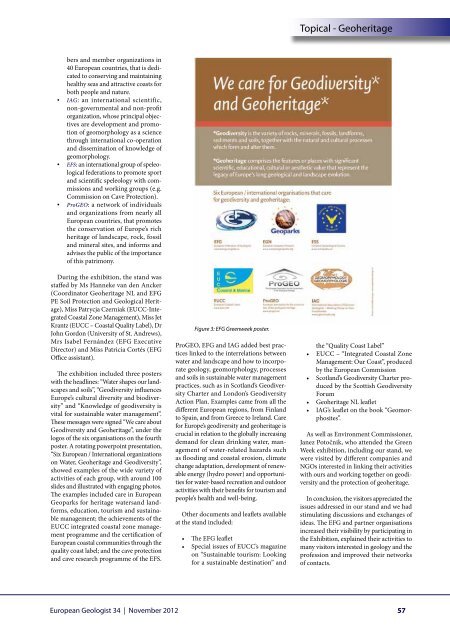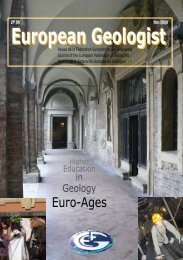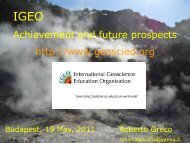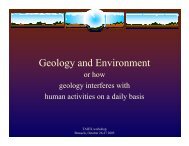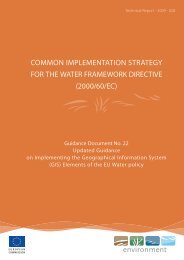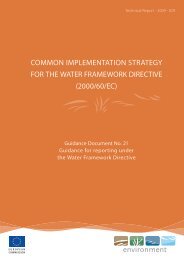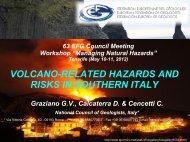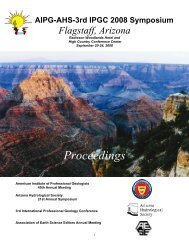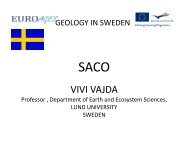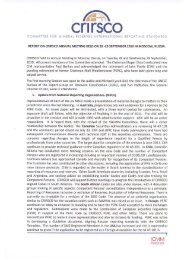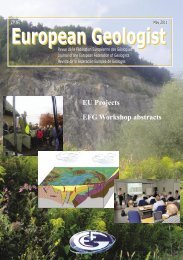European Geologist European Geologist Geoheritage - learning ...
European Geologist European Geologist Geoheritage - learning ...
European Geologist European Geologist Geoheritage - learning ...
You also want an ePaper? Increase the reach of your titles
YUMPU automatically turns print PDFs into web optimized ePapers that Google loves.
Topical - <strong>Geoheritage</strong><br />
bers and member organizations in<br />
40 <strong>European</strong> countries, that is dedicated<br />
to conserving and maintaining<br />
healthy seas and attractive coasts for<br />
both people and nature.<br />
• IAG: an international scientific,<br />
non-governmental and non-profit<br />
organization, whose principal objectives<br />
are development and promotion<br />
of geomorphology as a science<br />
through international co-operation<br />
and dissemination of knowledge of<br />
geomorphology.<br />
• EFS: an international group of speleological<br />
federations to promote sport<br />
and scientific speleology with commissions<br />
and working groups (e.g.<br />
Commission on Cave Protection).<br />
• ProGEO: a network of individuals<br />
and organizations from nearly all<br />
<strong>European</strong> countries, that promotes<br />
the conservation of Europe’s rich<br />
heritage of landscape, rock, fossil<br />
and mineral sites, and informs and<br />
advises the public of the importance<br />
of this patrimony.<br />
During the exhibition, the stand was<br />
staffed by Ms Hanneke van den Ancker<br />
(Coordinator <strong>Geoheritage</strong> NL and EFG<br />
PE Soil Protection and Geological Heritage),<br />
Miss Patrycja Czerniak (EUCC-Integrated<br />
Coastal Zone Management), Miss Jet<br />
Krantz (EUCC – Coastal Quality Label), Dr<br />
John Gordon (University of St. Andrews),<br />
Mrs Isabel Fernández (EFG Executive<br />
Director) and Miss Patricia Cortés (EFG<br />
Office assistant).<br />
The exhibition included three posters<br />
with the headlines: “Water shapes our landscapes<br />
and soils”, “Geodiversity influences<br />
Europe’s cultural diversity and biodiversity”<br />
and “Knowledge of geodiversity is<br />
vital for sustainable water management”.<br />
These messages were signed “We care about<br />
Geodiversity and <strong>Geoheritage</strong>”, under the<br />
logos of the six organisations on the fourth<br />
poster. A rotating powerpoint presentation,<br />
“Six <strong>European</strong> / International organizations<br />
on Water, <strong>Geoheritage</strong> and Geodiversity”,<br />
showed examples of the wide variety of<br />
activities of each group, with around 100<br />
slides and illustrated with engaging photos.<br />
The examples included care in <strong>European</strong><br />
Geoparks for heritage watersand landforms,<br />
education, tourism and sustainable<br />
management; the achievements of the<br />
EUCC integrated coastal zone management<br />
programme and the certification of<br />
<strong>European</strong> coastal communities through the<br />
quality coast label; and the cave protection<br />
and cave research programme of the EFS.<br />
Figure 3: EFG Greenweek poster.<br />
ProGEO, EFG and IAG added best practices<br />
linked to the interrelations between<br />
water and landscape and how to incorporate<br />
geology, geomorphology, processes<br />
and soils in sustainable water management<br />
practices, such as in Scotland’s Geodiversity<br />
Charter and London’s Geodiversity<br />
Action Plan. Examples came from all the<br />
different <strong>European</strong> regions, from Finland<br />
to Spain, and from Greece to Ireland. Care<br />
for Europe’s geodiversity and geoheritage is<br />
crucial in relation to the globally increasing<br />
demand for clean drinking water, management<br />
of water-related hazards such<br />
as flooding and coastal erosion, climate<br />
change adaptation, development of renewable<br />
energy (hydro power) and opportunities<br />
for water-based recreation and outdoor<br />
activities with their benefits for tourism and<br />
people’s health and well-being.<br />
Other documents and leaflets available<br />
at the stand included:<br />
• The EFG leaflet<br />
• Special issues of EUCC’s magazine<br />
on “Sustainable tourism: Looking<br />
for a sustainable destination” and<br />
the “Quality Coast Label”<br />
• EUCC – “Integrated Coastal Zone<br />
Management: Our Coast”, produced<br />
by the <strong>European</strong> Commission<br />
• Scotland’s Geodiversity Charter produced<br />
by the Scottish Geodiversity<br />
Forum<br />
• <strong>Geoheritage</strong> NL leaflet<br />
• IAG’s leaflet on the book “Geomorphosites”.<br />
As well as Environment Commissioner,<br />
Janez Potočnik, who attended the Green<br />
Week exhibition, including our stand, we<br />
were visited by different companies and<br />
NGOs interested in linking their activities<br />
with ours and working together on geodiversity<br />
and the protection of geoheritage.<br />
In conclusion, the visitors appreciated the<br />
issues addressed in our stand and we had<br />
stimulating discussions and exchanges of<br />
ideas. The EFG and partner organisations<br />
increased their visibility by participating in<br />
the Exhibition, explained their activities to<br />
many visitors interested in geology and the<br />
profession and improved their networks<br />
of contacts.<br />
<strong>European</strong> <strong>Geologist</strong> 34 | November 2012<br />
57


